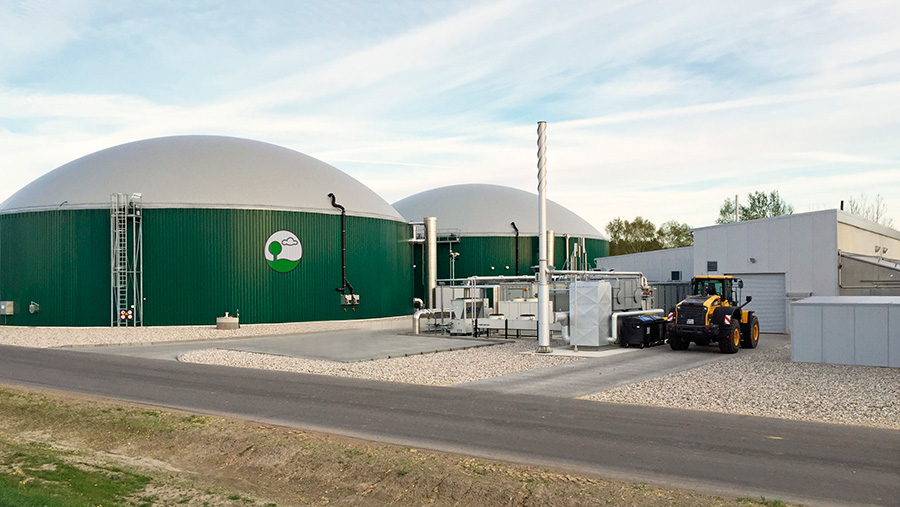Heating and transport offer big opportunities for biogas
 The Wormslade Farm AD Plant is expected to be similar to the one above when construction is completed © Raw Biogas
The Wormslade Farm AD Plant is expected to be similar to the one above when construction is completed © Raw Biogas Given the right support, the biogas sector has massive growth potential over coming years which could create big opportunities for farmers.
A five-fold increase in farm-based anaerobic digestion plants may seem unthinkable with current policy uncertainty, but it is possible if the correct support is put in place.
That was the message from one speaker at the Anaerobic Digestion and Bioresources Association (Adba) national conference in London (8 December), where delegates heard how biogas was central to meeting the need for cleaner sources of heating and transport fuel.
ADBA policy officer Thom Koller said new AD investment had been hit hard by support cuts, budget caps and legislative uncertainty, but insisted the sector could thrive longer-term if policy better reflected the diverse benefits the technology.
See also: Number of AD plants in UK grows to 540
“There are more than 200 on-farm AD plants now, more than in any other single sector. With the right support post-2020 we’re sure the industry could grow five times over. We could well achieve 1,000 [farm-based] plants,” said Mr Koller.
However, speakers said that stubbornly high technology costs meant financial support or significant cost savings remained essential.
Short-term prospects depended on the outcome of consultations on planned changes to Feed-in Tariffs and the Renewable Heat Incentive, due imminently, the added.
Energy in agricultural policy
The shape of farm support beyond 2020 was far from certain given Brexit, said Mr Koller, but AD could fit into future agricultural policy as it delivered a host of benefits such as manure/slurry management, soil improvement (digestate fertiliser) as well as greenhouse gas reduction.
“AD has an important role to play in decarbonising agriculture and diversifying rural incomes when they are hit by cuts in EU farm support,” added Chris Huhne, former secretary of state for energy and climate change.
“It can also balance peaks and troughs in grid supplies, when solar and wind cannot.”
See also: 30% of total English maize crop goes for anaerobic digestion
Acknowledging concerns about proposed RHI sustainability criteria and limits on crop-based AD, he urged policy makers to be “realistic” about the use of energy crops and insisted it wasn’t a trade-off between food and fuel.
“We’ve always used energy crops and AD technology requires them to get the most out of other waste feedstocks.”
Maize is the main crop-based feedstock and figures published last week show that 52,280ha was grown for AD by June 2016, up 55% on 2015. This equates to 29% of the total maize area and 1% of arable land.
Focus on green heating
Labour MP Caroline Flint said the importance of biogas to UK energy policy had been overlooked for too long and there were real opportunities for growth, especially for biomethane injection to the gas grid.
“Green gas should be an integral part of UK energy policy. Much attention has been paid to cleaning-up electricity supply, but heating is the real opportunity,” said Ms Flint.
More than 80% of UK homes were connected to the gas network and biomethane could meet more of this demand in future, although this required changes to policy and public attitudes, she added.
Ms Flint outlined four key requirements:
- Improve attitudes to waste-based biogas by working with communities to allay concerns
- Avoid stop-start policy to allow long-term investment decisions
- National and local co-ordination on food waste collections and green gas infrastructure
- Backing biogas for use in transport.
Around 2.5TWh of biomethane was injected into the grid this year and with favourable policy support that could rise to 6TWh by 2020, Adba’s Ollie More predicted.
Transport opportunity
Speakers welcomed the recent launch of a Department for Transport consultation on the Renewable Transport Fuels Obligation (RTFO), which supported a rise in the blending target for biofuels to 10% by 2020.
“Biomethane is strategically placed to help meet that target, although clarity is needed on some elements of the policy,” said Mr More.
Tony Griffiths from gas fuel specialists Gas Alliance said a number of commercial vehicle manufactures had already launched biomethane-powered models and he predicted a dramatic increase in future demand.
This was being driven by a need to reduce particulate and nitrogen oxide emissions and further rollout of cleaner “Euro VI” engines, he said.
Underlying policy drivers
- Paris agreement on climate change – UK signed up to legally-binding targets to limit global temperature rise
- UK’s Fifth Carbon Budget proposes to cut greenhouse gas emissions 57% (from 1990 levels) by 2030
- Government committed to producing an “Emissions Reduction Plan” detailing how to meet the 2030 target – due to be published Q1 2017. Industrial strategy to follow
- Committee on Climate Change will assess how well the ERP can meet targets and report to parliament next June
- Review of Levey Control Framework in the spring Budget
- Outcome of RHI and FiT consultations due imminently.
Hunting an affordable solution
The cost of AD technology remains one of the biggest challenges. Many plants are bespoke designs, which makes them expensive, but Andy Bull of Severn Wye Energy Agency said there could be scope to reduce costs by finding “off the peg” small-scale (15-30kW) plants designed to fit the average farm.
He is working with a number of farmers, regulators and other organisations in Wales to find such a system to suit typical 120-150-cow dairy farms.
The aim is to use the farms to demonstrate the successes and failures of the systems to drive uptake among farmers.
“If we can get it going in Wales, hopefully we can establish a model for the rest of the UK.”
